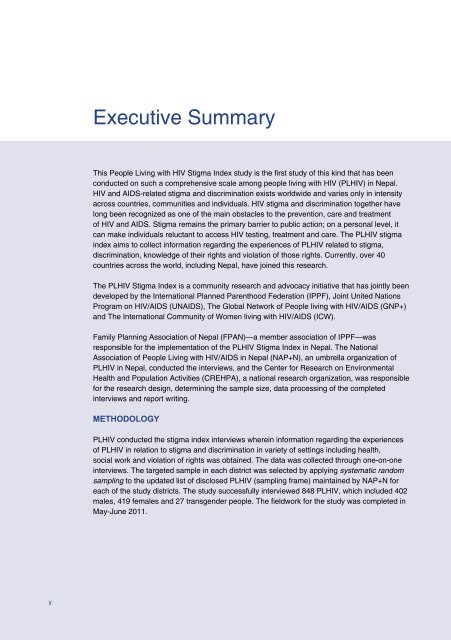PLHIV Stigma Index in Nepal
PLHIV Stigma Index in Nepal
PLHIV Stigma Index in Nepal
- No tags were found...
Create successful ePaper yourself
Turn your PDF publications into a flip-book with our unique Google optimized e-Paper software.
Executive SummaryThis People Liv<strong>in</strong>g with HIV <strong>Stigma</strong> <strong>Index</strong> study is the first study of this k<strong>in</strong>d that has beenconducted on such a comprehensive scale among people liv<strong>in</strong>g with HIV (<strong>PLHIV</strong>) <strong>in</strong> <strong>Nepal</strong>.HIV and AIDS-related stigma and discrim<strong>in</strong>ation exists worldwide and varies only <strong>in</strong> <strong>in</strong>tensityacross countries, communities and <strong>in</strong>dividuals. HIV stigma and discrim<strong>in</strong>ation together havelong been recognized as one of the ma<strong>in</strong> obstacles to the prevention, care and treatmentof HIV and AIDS. <strong>Stigma</strong> rema<strong>in</strong>s the primary barrier to public action; on a personal level, itcan make <strong>in</strong>dividuals reluctant to access HIV test<strong>in</strong>g, treatment and care. The <strong>PLHIV</strong> stigma<strong>in</strong>dex aims to collect <strong>in</strong>formation regard<strong>in</strong>g the experiences of <strong>PLHIV</strong> related to stigma,discrim<strong>in</strong>ation, knowledge of their rights and violation of those rights. Currently, over 40countries across the world, <strong>in</strong>clud<strong>in</strong>g <strong>Nepal</strong>, have jo<strong>in</strong>ed this research.The <strong>PLHIV</strong> <strong>Stigma</strong> <strong>Index</strong> is a community research and advocacy <strong>in</strong>itiative that has jo<strong>in</strong>tly beendeveloped by the International Planned Parenthood Federation (IPPF), Jo<strong>in</strong>t United NationsProgram on HIV/AIDS (UNAIDS), The Global Network of People liv<strong>in</strong>g with HIV/AIDS (GNP+)and The International Community of Women liv<strong>in</strong>g with HIV/AIDS (ICW).Family Plann<strong>in</strong>g Association of <strong>Nepal</strong> (FPAN)—a member association of IPPF—wasresponsible for the implementation of the <strong>PLHIV</strong> <strong>Stigma</strong> <strong>Index</strong> <strong>in</strong> <strong>Nepal</strong>. The NationalAssociation of People Liv<strong>in</strong>g with HIV/AIDS <strong>in</strong> <strong>Nepal</strong> (NAP+N), an umbrella organization of<strong>PLHIV</strong> <strong>in</strong> <strong>Nepal</strong>, conducted the <strong>in</strong>terviews, and the Center for Research on EnvironmentalHealth and Population Activities (CREHPA), a national research organization, was responsiblefor the research design, determ<strong>in</strong><strong>in</strong>g the sample size, data process<strong>in</strong>g of the completed<strong>in</strong>terviews and report writ<strong>in</strong>g.METHODOLOGY<strong>PLHIV</strong> conducted the stigma <strong>in</strong>dex <strong>in</strong>terviews where<strong>in</strong> <strong>in</strong>formation regard<strong>in</strong>g the experiencesof <strong>PLHIV</strong> <strong>in</strong> relation to stigma and discrim<strong>in</strong>ation <strong>in</strong> variety of sett<strong>in</strong>gs <strong>in</strong>clud<strong>in</strong>g health,social work and violation of rights was obta<strong>in</strong>ed. The data was collected through one-on-one<strong>in</strong>terviews. The targeted sample <strong>in</strong> each district was selected by apply<strong>in</strong>g systematic randomsampl<strong>in</strong>g to the updated list of disclosed <strong>PLHIV</strong> (sampl<strong>in</strong>g frame) ma<strong>in</strong>ta<strong>in</strong>ed by NAP+N foreach of the study districts. The study successfully <strong>in</strong>terviewed 848 <strong>PLHIV</strong>, which <strong>in</strong>cluded 402males, 419 females and 27 transgender people. The fieldwork for the study was completed <strong>in</strong>May-June 2011.KEY FINDINGSn Background CharacteristicsAge: A majority of the <strong>PLHIV</strong> (65%) participat<strong>in</strong>g <strong>in</strong> this survey belonged to the age group of25—39 years. Very few respondents (5%) were under the age of 25 years. Thirty per cent ofthe adult respondents were aged 40 years and above.Education: Relatively, females had lower levels of education than males and transgenderpeople. A considerable number of female respondents (44%) had never attended school.Approximately 15 per cent of the females, 16 per cent of the transgender people and 40 percent of the males had completed their lower secondary/secondary education. A significantnumber of transgender people (64%) had completed their School Leav<strong>in</strong>g Certificate (SLC)course and higher level of education, whereas only a small percentage of males (10%) andfemales (4%) had completed this course and higher level of education.Employment status: One-sixth of the respondents (17%) were unemployed. Among theemployed respondents, a majority of the males (30%) and females (47%) were engaged<strong>in</strong> agriculture/animal husbandry, followed by service (jobs at private or non-governmentorganizations) (27% male and 19% female) and bus<strong>in</strong>ess (10% male and 9% female). Amongthe transgender population, 33 per cent were <strong>in</strong>volved <strong>in</strong> service and 44 per cent belongedto the other category (i.e. student/work<strong>in</strong>g <strong>in</strong> India/sex worker). Only four per cent of thetransgender people were <strong>in</strong>volved <strong>in</strong> agriculture.Place of residence: Approximately two-thirds (63%) of the respondents were reportedlyresid<strong>in</strong>g <strong>in</strong> rural areas. As compared to males (58%) and transgender people (56%), a higherpercentage of females (69%) were resid<strong>in</strong>g <strong>in</strong> rural areas.Development regions: A greater number of <strong>PLHIV</strong> were covered from the Westerndevelopment region, because the highest number of districts were considered from thisregion, whereas the number of <strong>PLHIV</strong> was low <strong>in</strong> the Mid-Western region, because only twodistricts were covered <strong>in</strong> this region.Liv<strong>in</strong>g status: A total of 76 per cent of the male, 47 per cent of the female and 19 per centof the transgender respondents were married and liv<strong>in</strong>g together. Although very few maleswere separated/divorced (1%) or liv<strong>in</strong>g alone (2%), 8 per cent and 11 per cent of the femaleswere separated/divorced and liv<strong>in</strong>g alone, respectively. None of the <strong>in</strong>terviewed transgenderpeople was separated/divorced or liv<strong>in</strong>g alone. A vast majority of transgender (96%) and malerespondents (84%) and approximately half of the female respondents (46%) claimed that theywere sexually active.6v7vi
















